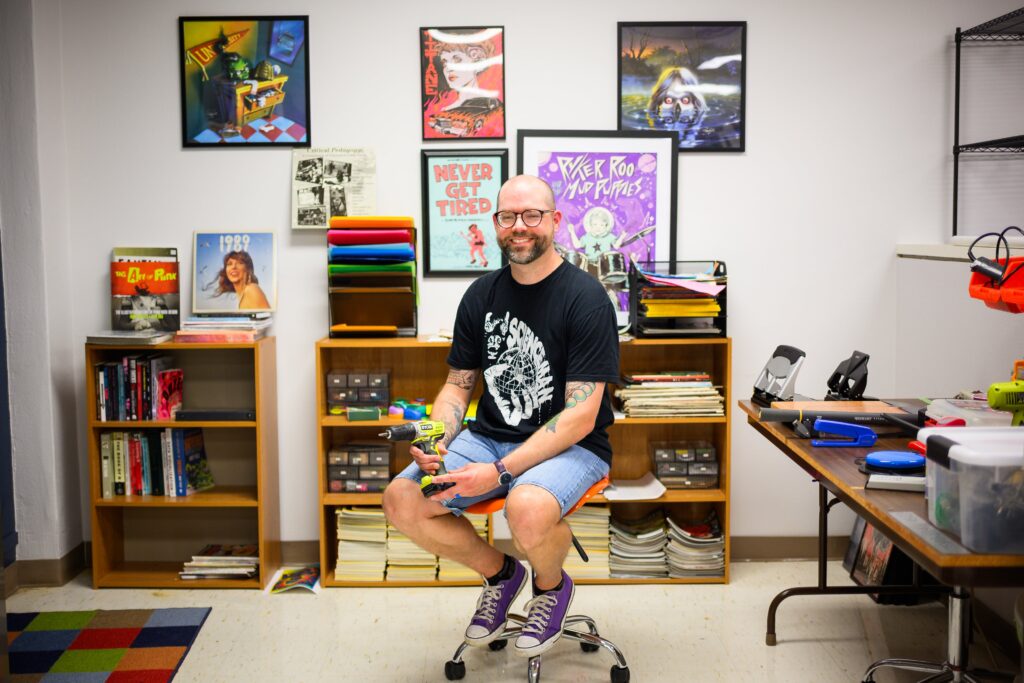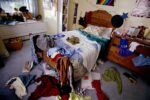Sam Logan didn’t know much about the body horror genre when he proposed teaching a class on it at Oregon State University.
So the associate professor set off to write his first short story in the horror fiction subgenre, drawing from a time his finger swelled after he smashed it in a car door. Without giving too much away, his story involved a needle and blood.
Logan hired an editor, who offered tough critiques. He welcomed them.
“I thrive in trying and doing,” he said, “and getting feedback and trying again.”
The 41-year-old brings the same mindset to his classroom. Logan said he values “co-creation” over traditional teaching doctrine — not teaching down to students, but learning alongside them.
That style represents his answer to two major forces pressing down on college campuses: anti-LGBTQ+ bias and artificial intelligence.
LGBTQ+ authors have frequently written body horror to express themes of identity as well as body and gender dysmorphia.
And in his other classes on punk music and Taylor Swift, Logan has students create “zines,” scrappy anti-establishment pamphlets crafted with anything at hand, as a way to learn a do-it-yourself creative philosophy.
A few years ago, Logan came up with Punk 101, a class that introduces students to punk music and zines and centers on BIPOC, queer and feminist artists, according to the course description.
In Punk 101, the parameters for the zine assignment almost don’t exist. One student, Lorelei, wrote about how cool the name is, he said. The zine ranked its various spellings and explored the name’s origins.
His classroom in the Oregon State Women’s Building basement is packed with evidence of his diverse interests: toy cars, posters, zines and vinyl records.
On a recent day, he’d pulled out his favorite Taylor Swift album, “1989 (Taylor’s Version),” which he teaches as part of his class on the pop icon, Swifties Unite.
Those students listen to Swift’s discography, rank songs on a scale of 1 to 10, then watch and discuss footage from Swift’s Eras Tour movie.
Like the punk students, they also make zines. One student’s dove deep into the “Cats” movie that starred Swift, Logan said.
Zines, he said, are a hands-on, experiential way to educate. They aren’t professionally made, but the different colors and language used represent each student’s individuality.
Like most teachers, Logan faces challenges with the rising use of generative artificial intelligence. He said he sees students becoming less and less engaged. But he views tactile construction as a way to resist the lulling effects of AI.
“I don’t believe that just because it’s here we have to adapt and use it,” he said of the technology.
In the spirit of his do-it-yourself attitude, Logan, who specializes in movement studies, learned how to fix up toy cars to help children with limited mobility through a national program called Go Baby Go.
Logan expanded the program in Oregon
, and when starting out, he had to learn new skills. Go Baby Go
retrofits toy cars so the toddlers can move around
. Logan had no idea how to work with electrical wires or other mechanics, he said, so he learned how to modify the cars.
Logan said he enjoyed seeing drivers become “little explorers for the first time.”
Back in Logan’s body horror course, students analyze short stories, many of them by queer authors, then set off to write their own.
In the current political climate, Logan said, he believes in “providing a space where queer students feel like it’s for them.”
Logan said he gives students three suggestions: One, draw on personal experience, like Logan did. Two, use identity, a common device among authors of the genre.
Lastly, he recommends students use their major. A health major could write a medical horror story.
All the while, he said, he’s learning more and more about gender from his students. And they’re exploring unfamiliar corners of their identities.
Logan said, “I just want to push them to do something new.”
— Kate DeWeese, Franklin High School
— Olivia Oldfield, Banks High School
This story was produced by student reporters as part of the High School Journalism Institute, an annual collaboration among The Oregonian/OregonLive, Oregon State University, and other Oregon media organizations. For more information or to support the program, go to
oregonlive.com/hsji
.
High School Journalism Institute 2025
-
Sick Town Roller Derby heats up in Corvallis
-
Affordable housing investment hits $220M in Oregon college town, but homelessness is on the rise
-
Commentary: Suicide hotline cuts deepen isolation among LGBTQ+ youth
-
Recent West Linn grad builds connections through language
-
To escape from academic stress, McMinnville junior finds passion for music





More Stories
Oregon State professor teaches punk, horror — and Taylor Swift
Oregon State professor teaches punk, horror — and Taylor Swift
Oregon State professor teaches punk, horror — and Taylor Swift